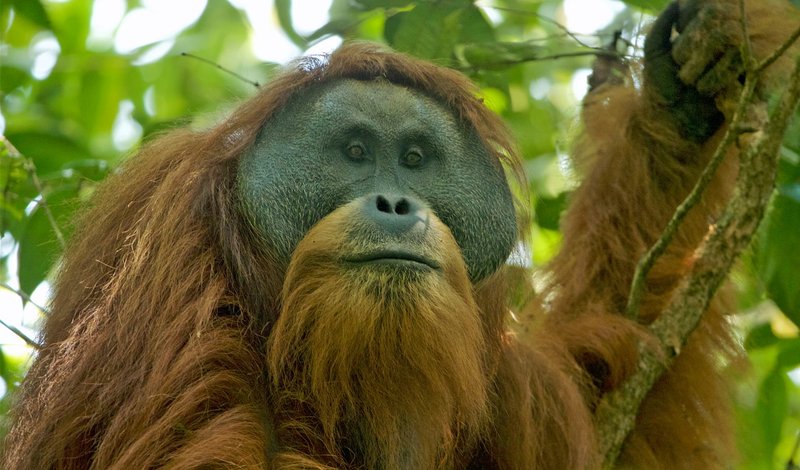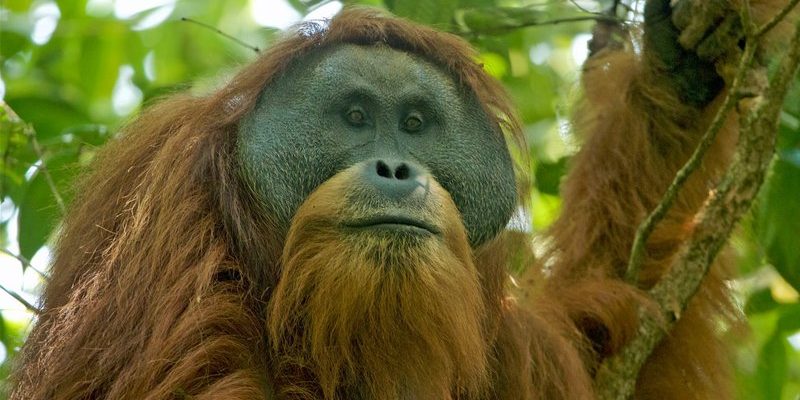
So, let’s dive into the fascinating world of the Tapanuli orangutan’s feeding habits and how they utilize their surroundings to survive in the wild. Picture them as the ultimate foodies of the forest, carefully selecting their meals and adapting to their habitat. In this article, we’ll explore their diet, hunting techniques, and how these traits help them thrive in their remote woodland homes.
Understanding the Tapanuli Orangutan’s Habitat
To grasp how the Tapanuli orangutan finds its food, it’s essential to understand where it lives. These orangutans inhabit the dense rainforests of North Sumatra, specifically in the Batang Toru ecosystem. This area is rich in biodiversity but also quite challenging due to its steep terrains and thick canopies. The trees create a layered vertical world where food is hidden high above the ground.
The evergreen trees here serve as both a playground and a pantry. Think of them as a multi-layered buffet where the orangutan has to navigate through various levels to find just the right dish. With such a complex environment, these orangutans are experts at utilizing their climbing skills to reach the tastiest fruits and leaves.
In this habitat, seasonal changes also play a vital role in what’s available to eat. During certain times of the year, particular fruits bloom, creating a feast for hungry orangutans. They have to be attentive and adaptable to make the most of these seasonal treats.
The Tapanuli Orangutan’s Diet
Let’s break down what the Tapanuli orangutan actually eats. At first glance, you might think they have a simple diet focused on fruits, but it’s a bit more complicated! These primates are primarily frugivorous, meaning they eat a lot of fruit. However, their menu can change based on what’s available in their environment.
Here’s a closer look at their diet:
- Fruits: Ripe fruits are their favorites. They enjoy a variety of fruits like figs, durian, and rambutan. These fruits are high in sugar and provide quick energy for their daily activities.
- Leaves and Flowers: When fruit isn’t in season, they shift to tender leaves and flowers. This helps supplement their diet and offers different nutrients.
- Bark and Wood: Surprisingly, they sometimes eat bark and even wood, especially during lean times. This might not sound tasty to us, but it gives them the necessary fibers and minerals.
You might be wondering how they know what to eat. Their keen sense of smell helps them identify ripe fruits from afar. It’s like having an all-natural GPS that guides them to delicious snacks!
Hunting Strategies of the Tapanuli Orangutan
Now, you might think that since orangutans are mostly fruit eaters, they don’t really “hunt” like some other animals. Here’s the thing: while they don’t hunt in the traditional sense, they do have clever strategies for securing their food.
First, let’s talk about foraging. Tapanuli orangutans are incredible foragers, using their intelligence and memory to find food across their territory. They remember where certain trees bear fruit and return to those spots at the right times. This knack for spatial awareness is like having a mental map of their favorite dining spots.
When it comes to getting their meals, they utilize their strong limbs and swinging abilities to access fruits high up in the trees. Watching them climb is like watching a skilled acrobat in action. They expertly navigate branches, demonstrating their strength and agility.
Sometimes, they even use tools! It’s not common, but they’ve been seen using sticks to extract insects or honey from crevices. This ability to manipulate objects shows their intelligence and adaptability—traits that are essential for survival in the wild.
The Role of Social Structure
Interestingly, the social structure of Tapanuli orangutans also influences their hunting and foraging behaviors. Unlike some other primate species, orangutans are largely solitary. However, females with offspring may share knowledge about food locations. It’s like a mother teaching her child the best places to find their favorite snacks.
This social learning is crucial, especially for young orangutans. They observe their mothers and slowly learn the ropes of foraging. This passing down of knowledge helps ensure that the next generation knows what to eat and where to find it, which is vital for their survival.
Males, on the other hand, tend to be more solitary, spending less time with young orangutans. They cover large territories, which can create challenges for finding food. So, these males have developed their own strategies to navigate the forest and sustain themselves.
The Impact of Environmental Changes
Sadly, deforestation and habitat destruction pose significant threats to the Tapanuli orangutan’s survival. With fewer trees, their food sources are dwindling, which affects their diet and hunting strategies. Imagine suddenly losing access to your favorite restaurants—all those delicious options would be gone!
As their habitats shrink, these orangutans are forced to travel further to find food. This puts them at risk, as longer travels mean more exposure to predators and human encounters. Conservation efforts are crucial to protect their environment and ensure they have enough to eat.
Additionally, deforestation leads to habitat fragmentation, making it harder for orangutans to find one another and establish social bonds. With declining populations, the knowledge shared among them can also be lost, which can affect future generations.
Conservation Efforts and Their Importance
To help the Tapanuli orangutan thrive, several conservation initiatives are underway. These efforts focus on protecting their habitat and ensuring they have access to food sources. Organizations are working to create protected areas that reduce human encroachment and preserve the forest that the orangutans rely on.
Moreover, educating local communities about the importance of orangutans and their role in the ecosystem plays a significant part in conservation. When people understand how vital these creatures are, they’re more likely to participate in preservation efforts.
Reforestation projects are also essential. Planting native trees not only helps restore their habitat but also provides food sources for the orangutans. It’s like creating a new, sustainable buffet for them to enjoy!
The Tapanuli orangutan is a truly remarkable species with a unique diet and hunting strategies that are finely tuned to its environment. As they navigate their lush forest homes, they remind us of the delicate balance of nature. Protecting these incredible creatures starts with understanding them—what they eat, how they live, and the challenges they face.
By raising awareness and supporting conservation efforts, we can help ensure that the Tapanuli orangutan continues to swing through the trees for generations to come. So next time you think about these fuzzy forest dwellers, remember their intricate lifestyles and the importance of preserving their home. Together, we can savor the beauty of their existence and the richness of their diet in the wild.

